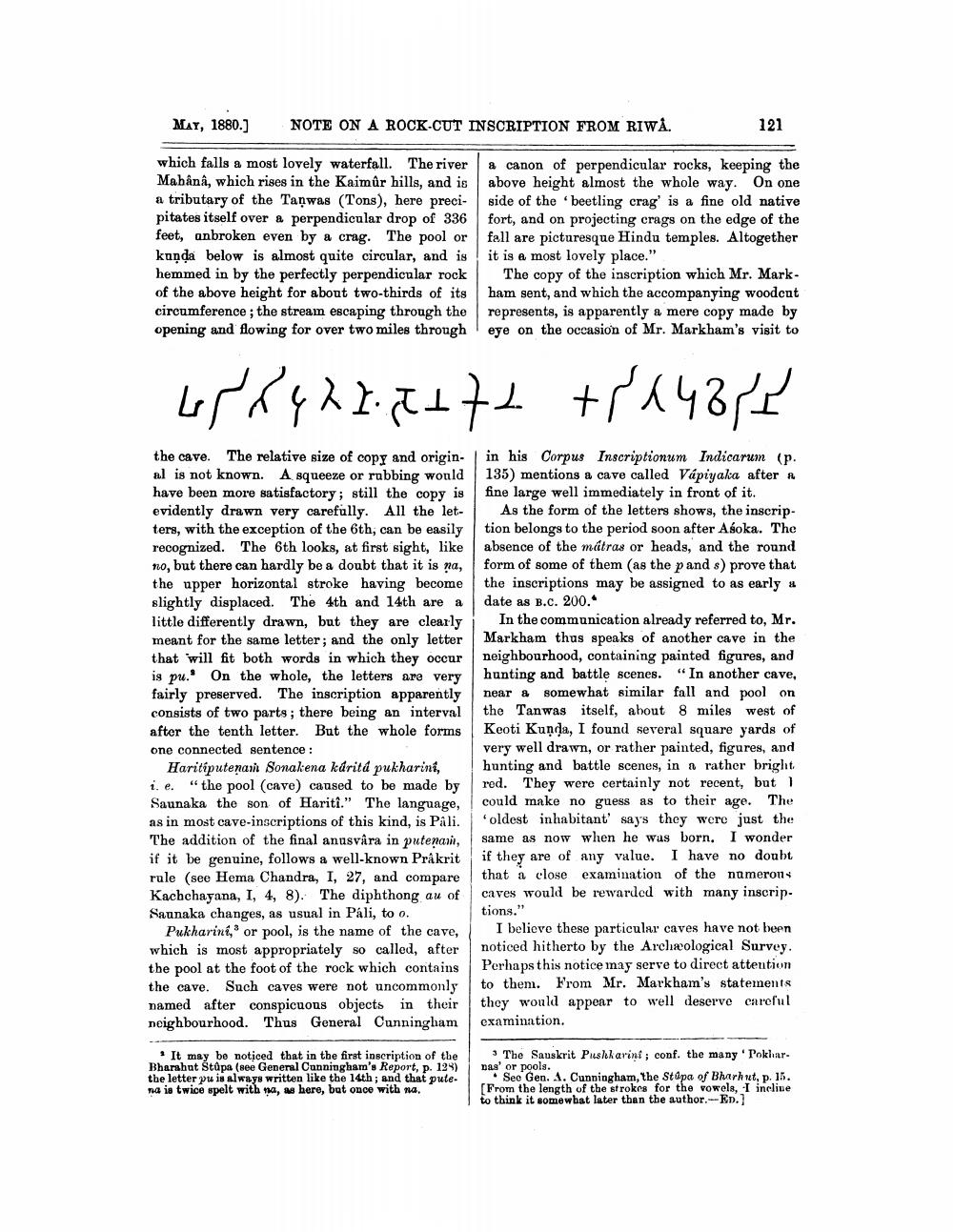________________
MAY, 1880.7
NOTE ON A ROCK-CUT INSCRIPTION FROM RIWA.
121
which falls a most lovely waterfall. The river & canon of perpendicular rocks, keeping the Mabânâ, which rises in the Kaimûr hills, and is above height almost the whole way. On one a tributary of the Taņwas (Tons), here preci-| side of the beetling crag' is a fine old native pitates itself over a perpendicular drop of 336 fort, and on projecting crags on the edge of the feet, anbroken even by a crag. The pool or fall are picturesque Hindu temples. Altogether kunda below is almost quite circular, and is it is a most lovely place." hemmed in by the perfectly perpendicular rock The copy of the inscription which Mr. Markof the above height for about two-thirds of its ham sent, and which the accompanying woodent circumference; the stream escaping through the represents, is apparently a mere copy made by opening and flowing for over two miles through eye on the occasion of Mr. Markham's visit to
W/8422gtttt tra48/
the cave. The relative size of copy and origin al is not known. A squeeze or rubbing would have been more satisfactory; still the copy is evidently drawn very carefully. All the letters, with the exception of the 6th, can be easily recognized. The 6th looks, at first sight, like no, but there can hardly be a doubt that it is na, the upper horizontal stroke having become slightly displaced. The 4th and 14th are a little differently drawn, but they are clearly meant for the same letter; and the only letter that will fit both words in which they occur is pu.' On the whole, the letters are very fairly preserved. The inscription apparently consists of two parts; there being an interval after the tenth letter. But the whole forms one connected sentence :
Haritiputena Sonakena kårità pukharini, i. e. "the pool (cave) caused to be made by Saunaka the son of Hariti." The language, as in most cave-inscriptions of this kind, is Pali. The addition of the final anusvåra in putenari, if it be genuine, follows a well-known Prakrit rule (see Hema Chandra, I, 27, and compare Kachchayana, 1, 4, 8). The diphthong au of Saunaka changes, as usual in Páli, to o.
Pukharini, or pool, is the name of the cave, which is most appropriately so called, after the pool at the foot of the rock which contains the cave. Such caves were not uncommonly named after conspicuous objects in their neighbourhood. Thus General Cunningham
in his Corpus Inscriptionum Indicarum (p. 135) mentions a cave called Vápiyaka after a fine large well immediately in front of it.
As the form of the letters shows, the inscription belongs to the period soon after Asoka. The absence of the matras or heads, and the round form of some of them (as the p and 8) prove that the inscriptions may be assigned to as early # date as B.C. 200.
In the communication already referred to, Mr. Markham thus speaks of another cave in the neighbourhood, containing painted figures, and hunting and battle scenes. "In another cave, near & somewhat similar fall and pool on the Tanwas itself, about 8 miles west of Keoti Kunda, I found several square yards of very well drawn, or rather painted, figures, and hunting and battle scenes, in a rather bright rod. They were certainly not recent, but I could make no guess as to their age. The
oldest inhabitant' says they were just the same as now when he was born. I wonder if they are of any value. I have no doubt that a close examination of the numerous caves would be rewarded with many inscriptions."
I believe these particular caves have not been noticed hitherto by the Archæological Survey. Perhaps this notice may serve to direct attention to them. From Mr. Markham's statements they would appear to well deserve careful examination.
. It may be noticed that in the first inscription of the Bharahut Stúpa (see General Cunningham's Report, p. 129) the letter pu is always written like the 14th ; and that putena is twice spelt with na, as here, but once with na.
The Sauskrit Pushkarini; conf. the many 'Pokhari pas' or pools.
Sec Gen. 4. Cunningham, the Stupa of Bharhut, p. 15. From the length of the strokes for the vowels, I incline to think it somewhat later than the author.--ED.




